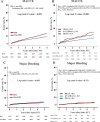Implication of diabetic status on platelet reactivity and clinical outcomes after drug-eluting stent implantation: results from the PTRG-DES consortium
- PMID: 37679760
- PMCID: PMC10486029
- DOI: 10.1186/s12933-023-01976-4
Implication of diabetic status on platelet reactivity and clinical outcomes after drug-eluting stent implantation: results from the PTRG-DES consortium
Abstract
Background: Diabetes mellitus (DM) is associated with thrombogenicity, clinically manifested with atherothrombotic events after percutaneous cutaneous intervention (PCI). This study aimed to investigate association between DM status and platelet reactivity, and their prognostic implication in PCI-treated patients.
Methods: The Platelet function and genoType-Related long-term Prognosis-Platelet Function Test (PTRG-PFT) cohort was established to determine the linkage of platelet function test (PFT) with long-term prognosis during dual antiplatelet therapy including clopidogrel in patients treated with drug-eluting stent (DES). We assessed platelet reactivity using VerifyNow and 'high platelet reactivity (HPR)' was defined as ≥ 252 P2Y12 reaction unit (PRU). Major adverse cardiac and cerebrovascular event (MACCE) was a composite of all-cause death, myocardial infarction, stent thrombosis or stroke.
Results: Between July 2003 and Aug 2018, DES-treated patients with available PFT were enrolled (n = 11,714). Diabetic patients demonstrated significant higher levels of platelet reactivity (DM vs. non-DM: 225.7 ± 77.5 vs. 213.6 ± 79.1 PRU, P < 0.001) and greater prevalence of HPR compared to non-diabetic patients (38.1% vs. 32.0%, P < 0.001). PRU level and prevalence of HPR were significantly associated with insulin requirement and HbA1c level, as well as diabetic status. DM status and HPR phenotype had a similar prognostic implication, which showed the synergistic clinical impact on MACCE. Association between PRU level and MACCE occurrence seemed higher in diabetic vs. non-diabetic patients. In non-DM patients, HPR phenotype did not significantly increase the risk of MACCE (adjusted hazard ratio [HRadj]: 1.073; 95% confidence interval [CI]: 0.869-1.325; P = 0.511), whereas HPR was an independent determinant for MACCE occurrence among diabetic patients (HRadj: 1.507; 95% CI: 1.193-1.902; P < 0.001).
Conclusion: The levels of on-clopidogrel platelet reactivity are determined by diabetic status and the severity of DM. In addition, HPR phenotype significantly increases the risk of MACCE only in diabetic patients.
Clinical trial registration: URL: https://www.
Clinicaltrials: gov . Unique identifier: NCT04734028.
Keywords: Diabetes mellitus; Hemoglobin A1c; Insulin; Platelet reactivity; Stenting.
© 2023. BioMed Central Ltd., part of Springer Nature.
Conflict of interest statement
Dr. Jeong has received honoraria for lectures from AstraZeneca, Daiichi Sankyo, Sanofi-Aventis, Han-mi Pharmaceuticals, and Yuhan Pharmaceuticals, as well as research grants or support from Yuhan Pharmaceuticals and U&I Corporation. Dr. Song has received honoraria for lectures from AstraZeneca, Daiichi Sankyo, Sanofi-Aventis, Bayer Korea, and Samjin Pharmaceutical. Dr. Joo has received honoraria for lectures from AstraZeneca, Hanmi, Samjin, Dong-A, HK inno. N Pharmaceuticals, and DIO Medical Ltd. The other authors have no potential conflicts of interest to disclose.
Figures




References
-
- Schramm TK, Gislason GH, Kober L, Rasmussen S, Rasmussen JN, Abildstrom SZ, et al. Diabetes patients requiring glucose-lowering therapy and nondiabetics with a prior myocardial infarction carry the same cardiovascular risk: a population study of 3.3 million people. Circulation. 2008;117:1945–54. doi: 10.1161/CIRCULATIONAHA.107.720847. - DOI - PubMed
-
- American Diabetes A. 9. Cardiovascular Disease and Risk Management: Standards of Medical Care in Diabetes-2018. Diabetes Care 2018;41:S86-S104. - PubMed
Publication types
MeSH terms
Substances
Associated data
LinkOut - more resources
Full Text Sources
Medical
Miscellaneous

